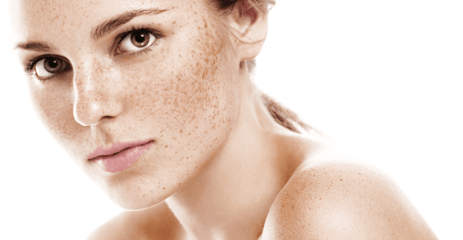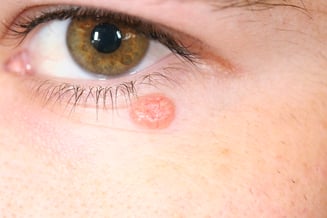Over time, excessive exposure to the sun’s ultraviolet rays can cause long-term damages to the skin, manifesting as unsightly wrinkles, blemishes and more serious issues such as skin cancer.While exposure to sunlight in moderation can be beneficial for our body’s natural production of vitamin D, overexposure to ultraviolet rays can be highly detrimental with consequences that can sneak up on you in five- or ten-years’ time.
What to do for sun damage prevention
The number-one rule of sun damage prevention is wearing ¼ teaspoon of broad-spectrum sunscreen with a minimum of SPF 30. Make sure it is the last step of your skincare routine in the morning and leave 20 minutes before heading out into the sun if you are using a chemical sunscreen instead of a physical sunscreen.
For more thorough protection against harmful sun rays, invest in an SPF-infused lip balm and wear 100% UV400 sunglasses that offer both UVA and UVB protection for the sensitive area around the eyes.
Related: Choosing the Best Sunscreen for Your Skin Type
What happens to skin after excessive sun exposure?
The immediate effects of sun damage are apparent through sunburns. Painful first- to second-degree sunburn usually develops 4-5 hours after sun exposure, identified through redness, tenderness, swelling and blisters. Next comes the inevitable suntan, caused by ultraviolet rays penetrating the top layer of skin and damaging cells in the deeper layers. This triggers the production of melanin, which darkens the skin.
 Melasma can show up as tan or brown patches on your face and can worsen with sun exposure. Sun damage can also cause scaly patches called actinic keratosis to form, which are red, brown or skin-colored patches that are noticeably rough to the touch. Uneven skin tone can occur as a result of permanently damaged small blood vessels, causing skin to look reddish in areas.
Melasma can show up as tan or brown patches on your face and can worsen with sun exposure. Sun damage can also cause scaly patches called actinic keratosis to form, which are red, brown or skin-colored patches that are noticeably rough to the touch. Uneven skin tone can occur as a result of permanently damaged small blood vessels, causing skin to look reddish in areas.
Sun damage is a significant factor for wrinkles and premature aging. The sun’s ultraviolet rays can permanently damage collagen and elastic tissue deep within the skin, which causes sagging and the skin’s inability to regenerate damaged cells.

Long-term exposure to sun can also lead to the worst possible consequence of sun.
damage – the development of various skin cancers. Three common types include Basal Cell Carcinoma (BCC), which usually appears pink, raised and shiny, and almost like a scab that recurs in the same spot; Squamous Cell Carcinoma (SCC), which can vary in size and severity and may require surgery for removal; and Malignant Melanoma, the most dangerous cancer that occurs on any area there are pigment-producing cells. The older you are with naturally lighter skin, the greater your risk of developing skin cancer, so continue to do regular skin checks if you tick those boxes.
Self-care and home remedy solutions for sun damaged skin
A momentary lapse in judgment under the sun is all it takes to develop sunburn. Act quickly and cool down burned areas with a cold compress. Soothe burns with fresh aloe vera plant, or alternatively, use a 100% aloe vera gel from the pharmacy. For more serious burns, take anti-inflammatory drugs and use a mild corticosteroid such as Hydrocortisone cream to relieve discomfort.
Related: Fighting dark spots, blemishes, and splotchy skin
To reduce the appearance of physical long-term effects of sun damage such as wrinkles and dark spots, there are a few ingredients you can look out for in your daily skincare products. Don't pop any blisters, severe and widespread blisters warrant doctor's attention.
-
Hydroquinone
Hydroquinone is a proven effective skin-lightening agent that potentially fades the appearance of freckles, melasma and age spots by preventing the excess production of melanin in the skin.
-
Retinoids
Along with smoothing out stubborn wrinkles, Vitamin A derivatives such as retinol work to speed up the turnover and shedding of pigmented cells. This results in faded hyperpigmentation and improvement of skin texture.
-
Vitamin C
Vitamin C is the gold standard for anti-aging and repairing existing skin damage, achieved by neutralizing free radicals and stimulating collagen production. It helps to protect your skin further from sun rays when used alongside broad-spectrum sunscreen, so we advise adding a healthy dose of Vit C into your daily morning skincare regimen.
-
Different methods to speed up the skin cycle
Thanks to modern beauty technology, self-care can now go a long way in treating sun damaged skin. Minimally abrasive skin treatments you can explore include Cryotherapy, a freezing technique using liquid nitrogen to remove skin lesions such as actinic keratosis; Chemical Peel, which improves skin texture by removing the outer layer of old skin, making way for new, brighter and more youthful-looking skin; and Microdermabrasion, a cosmetic procedure that gently sands the skin to remove the uneven outer layer, remediating problems such as dull skin and age spots.
-
Light Therapy
Phototherapy Facial Treatment is a non-invasive, low-level light therapy that stimulates natural cellular response to improve skin texture, fade blemishes, and promote cell regeneration. Green and yellow LED lights with wavelengths of 520-580 nm have been proven to treat hyperpigmentation from sun damage. Pamper your skin in the comforts of home with Deesse LED Phototherapy Face Mask Device Premium Pro.
When it comes to sun damage, prevention is easier than reversal. Whether you’re going outside to walk your dog or do a grocery run, remember to respect the sun’s almighty strength and keep your skin protected at all times.
.png?width=180&height=80&name=imgpsh_fullsize_anim%20(1).png)

